Assessment 1 Coaching Portfolio: Peer Coaching Experience
VerifiedAdded on 2023/04/21
|11
|3176
|237
Portfolio
AI Summary
This coaching portfolio documents the peer coaching experience with a 37-year-old working woman, focusing on improving her self-motivation in parenting and professional life using the TGROW model. The portfolio includes details from the first and last coaching sessions, highlighting the techniques used to build rapport, identify goals, and develop strategies. The first session involved informal chats and probing questions to understand the client's cognitive and behavioral aspects, while the last session focused on feedback and reinforcing the client's role in her personal development. The coach reflects on the overall success of the sessions, acknowledging personal drawbacks and emphasizing the importance of continuous reflection and ethical practice. The experience underscored the significance of spontaneity and knowledge of psychological theories in effective coaching interventions, concluding that both the coach and coachee gain valuable insights into human behavior and coping mechanisms.
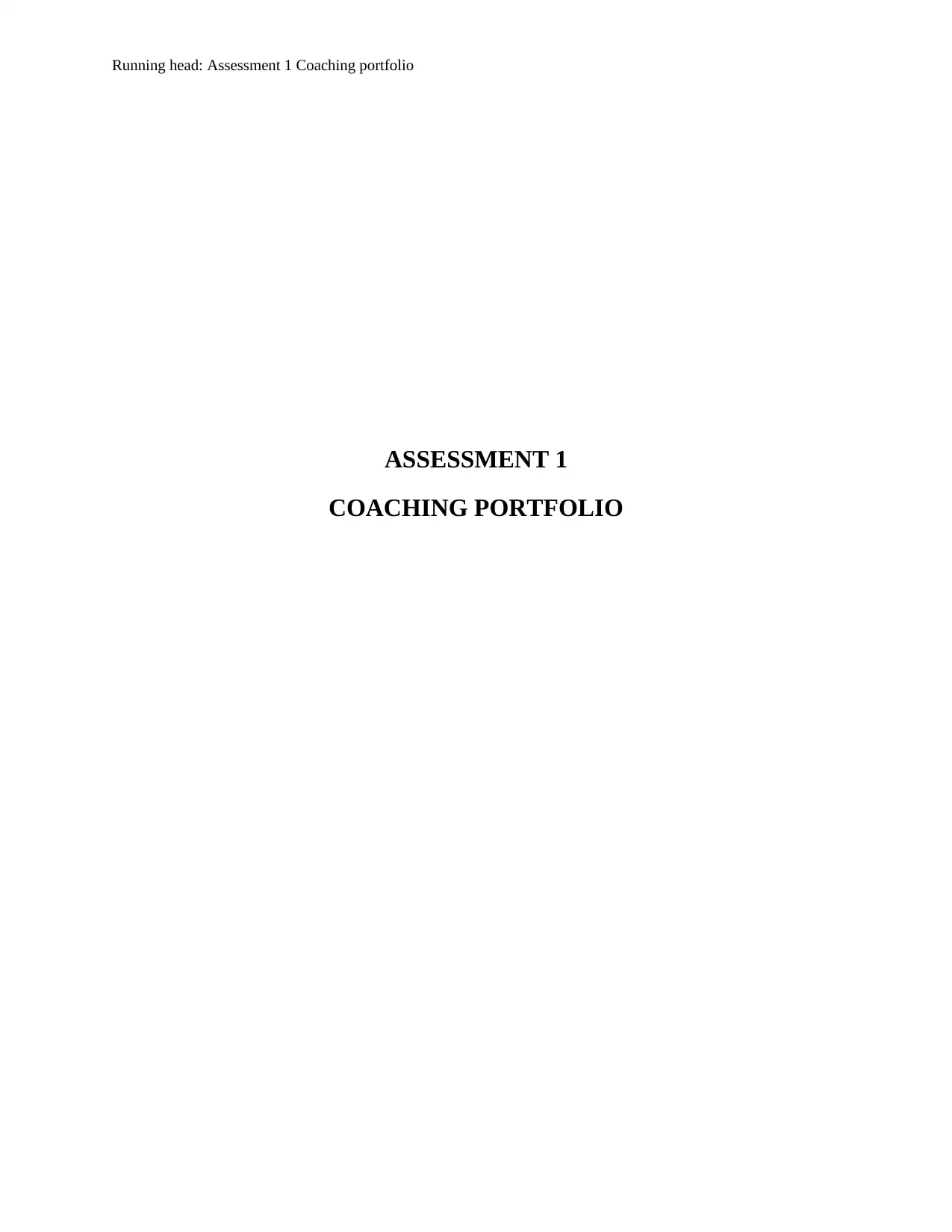
Running head: Assessment 1 Coaching portfolio
ASSESSMENT 1
COACHING PORTFOLIO
ASSESSMENT 1
COACHING PORTFOLIO
Paraphrase This Document
Need a fresh take? Get an instant paraphrase of this document with our AI Paraphraser

1
Assessment 1 Coaching portfolio
Table of Contents
Introduction......................................................................................................................................1
Case study........................................................................................................................................2
First session.....................................................................................................................................3
Last session......................................................................................................................................4
Own reflection.................................................................................................................................4
Conclusion.......................................................................................................................................5
Assessment 1 Coaching portfolio
Table of Contents
Introduction......................................................................................................................................1
Case study........................................................................................................................................2
First session.....................................................................................................................................3
Last session......................................................................................................................................4
Own reflection.................................................................................................................................4
Conclusion.......................................................................................................................................5
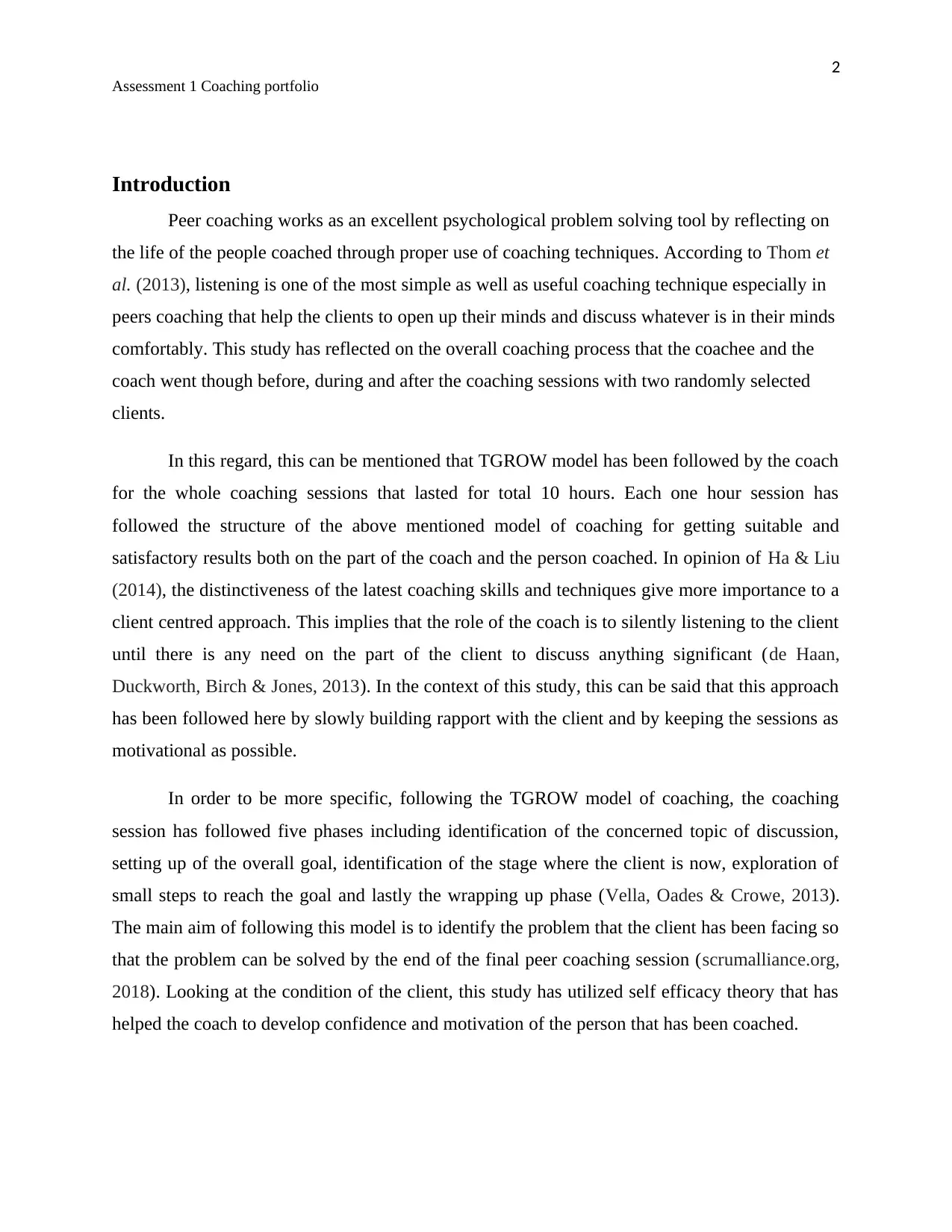
2
Assessment 1 Coaching portfolio
Introduction
Peer coaching works as an excellent psychological problem solving tool by reflecting on
the life of the people coached through proper use of coaching techniques. According to Thom et
al. (2013), listening is one of the most simple as well as useful coaching technique especially in
peers coaching that help the clients to open up their minds and discuss whatever is in their minds
comfortably. This study has reflected on the overall coaching process that the coachee and the
coach went though before, during and after the coaching sessions with two randomly selected
clients.
In this regard, this can be mentioned that TGROW model has been followed by the coach
for the whole coaching sessions that lasted for total 10 hours. Each one hour session has
followed the structure of the above mentioned model of coaching for getting suitable and
satisfactory results both on the part of the coach and the person coached. In opinion of Ha & Liu
(2014), the distinctiveness of the latest coaching skills and techniques give more importance to a
client centred approach. This implies that the role of the coach is to silently listening to the client
until there is any need on the part of the client to discuss anything significant (de Haan,
Duckworth, Birch & Jones, 2013). In the context of this study, this can be said that this approach
has been followed here by slowly building rapport with the client and by keeping the sessions as
motivational as possible.
In order to be more specific, following the TGROW model of coaching, the coaching
session has followed five phases including identification of the concerned topic of discussion,
setting up of the overall goal, identification of the stage where the client is now, exploration of
small steps to reach the goal and lastly the wrapping up phase (Vella, Oades & Crowe, 2013).
The main aim of following this model is to identify the problem that the client has been facing so
that the problem can be solved by the end of the final peer coaching session (scrumalliance.org,
2018). Looking at the condition of the client, this study has utilized self efficacy theory that has
helped the coach to develop confidence and motivation of the person that has been coached.
Assessment 1 Coaching portfolio
Introduction
Peer coaching works as an excellent psychological problem solving tool by reflecting on
the life of the people coached through proper use of coaching techniques. According to Thom et
al. (2013), listening is one of the most simple as well as useful coaching technique especially in
peers coaching that help the clients to open up their minds and discuss whatever is in their minds
comfortably. This study has reflected on the overall coaching process that the coachee and the
coach went though before, during and after the coaching sessions with two randomly selected
clients.
In this regard, this can be mentioned that TGROW model has been followed by the coach
for the whole coaching sessions that lasted for total 10 hours. Each one hour session has
followed the structure of the above mentioned model of coaching for getting suitable and
satisfactory results both on the part of the coach and the person coached. In opinion of Ha & Liu
(2014), the distinctiveness of the latest coaching skills and techniques give more importance to a
client centred approach. This implies that the role of the coach is to silently listening to the client
until there is any need on the part of the client to discuss anything significant (de Haan,
Duckworth, Birch & Jones, 2013). In the context of this study, this can be said that this approach
has been followed here by slowly building rapport with the client and by keeping the sessions as
motivational as possible.
In order to be more specific, following the TGROW model of coaching, the coaching
session has followed five phases including identification of the concerned topic of discussion,
setting up of the overall goal, identification of the stage where the client is now, exploration of
small steps to reach the goal and lastly the wrapping up phase (Vella, Oades & Crowe, 2013).
The main aim of following this model is to identify the problem that the client has been facing so
that the problem can be solved by the end of the final peer coaching session (scrumalliance.org,
2018). Looking at the condition of the client, this study has utilized self efficacy theory that has
helped the coach to develop confidence and motivation of the person that has been coached.
⊘ This is a preview!⊘
Do you want full access?
Subscribe today to unlock all pages.

Trusted by 1+ million students worldwide
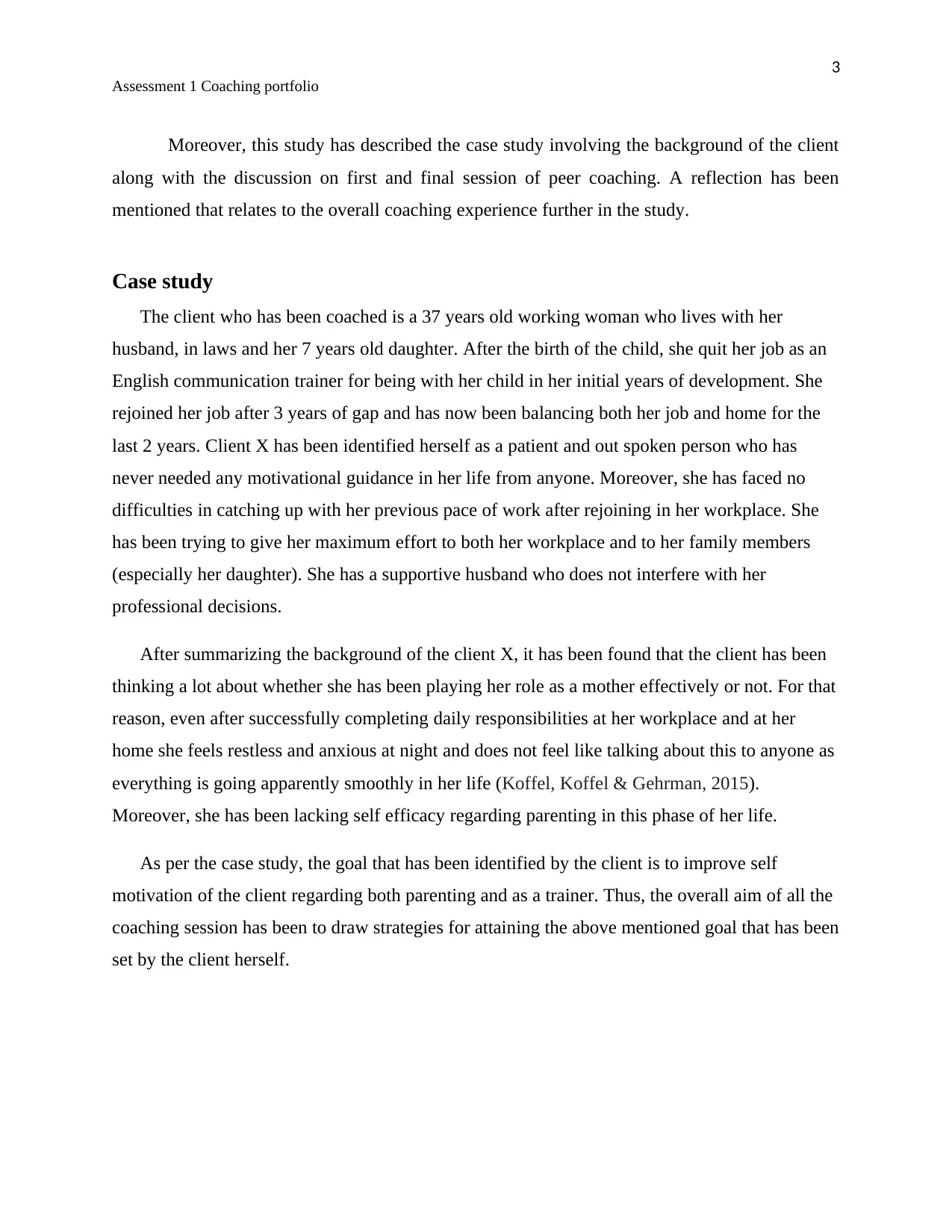
3
Assessment 1 Coaching portfolio
Moreover, this study has described the case study involving the background of the client
along with the discussion on first and final session of peer coaching. A reflection has been
mentioned that relates to the overall coaching experience further in the study.
Case study
The client who has been coached is a 37 years old working woman who lives with her
husband, in laws and her 7 years old daughter. After the birth of the child, she quit her job as an
English communication trainer for being with her child in her initial years of development. She
rejoined her job after 3 years of gap and has now been balancing both her job and home for the
last 2 years. Client X has been identified herself as a patient and out spoken person who has
never needed any motivational guidance in her life from anyone. Moreover, she has faced no
difficulties in catching up with her previous pace of work after rejoining in her workplace. She
has been trying to give her maximum effort to both her workplace and to her family members
(especially her daughter). She has a supportive husband who does not interfere with her
professional decisions.
After summarizing the background of the client X, it has been found that the client has been
thinking a lot about whether she has been playing her role as a mother effectively or not. For that
reason, even after successfully completing daily responsibilities at her workplace and at her
home she feels restless and anxious at night and does not feel like talking about this to anyone as
everything is going apparently smoothly in her life (Koffel, Koffel & Gehrman, 2015).
Moreover, she has been lacking self efficacy regarding parenting in this phase of her life.
As per the case study, the goal that has been identified by the client is to improve self
motivation of the client regarding both parenting and as a trainer. Thus, the overall aim of all the
coaching session has been to draw strategies for attaining the above mentioned goal that has been
set by the client herself.
Assessment 1 Coaching portfolio
Moreover, this study has described the case study involving the background of the client
along with the discussion on first and final session of peer coaching. A reflection has been
mentioned that relates to the overall coaching experience further in the study.
Case study
The client who has been coached is a 37 years old working woman who lives with her
husband, in laws and her 7 years old daughter. After the birth of the child, she quit her job as an
English communication trainer for being with her child in her initial years of development. She
rejoined her job after 3 years of gap and has now been balancing both her job and home for the
last 2 years. Client X has been identified herself as a patient and out spoken person who has
never needed any motivational guidance in her life from anyone. Moreover, she has faced no
difficulties in catching up with her previous pace of work after rejoining in her workplace. She
has been trying to give her maximum effort to both her workplace and to her family members
(especially her daughter). She has a supportive husband who does not interfere with her
professional decisions.
After summarizing the background of the client X, it has been found that the client has been
thinking a lot about whether she has been playing her role as a mother effectively or not. For that
reason, even after successfully completing daily responsibilities at her workplace and at her
home she feels restless and anxious at night and does not feel like talking about this to anyone as
everything is going apparently smoothly in her life (Koffel, Koffel & Gehrman, 2015).
Moreover, she has been lacking self efficacy regarding parenting in this phase of her life.
As per the case study, the goal that has been identified by the client is to improve self
motivation of the client regarding both parenting and as a trainer. Thus, the overall aim of all the
coaching session has been to draw strategies for attaining the above mentioned goal that has been
set by the client herself.
Paraphrase This Document
Need a fresh take? Get an instant paraphrase of this document with our AI Paraphraser
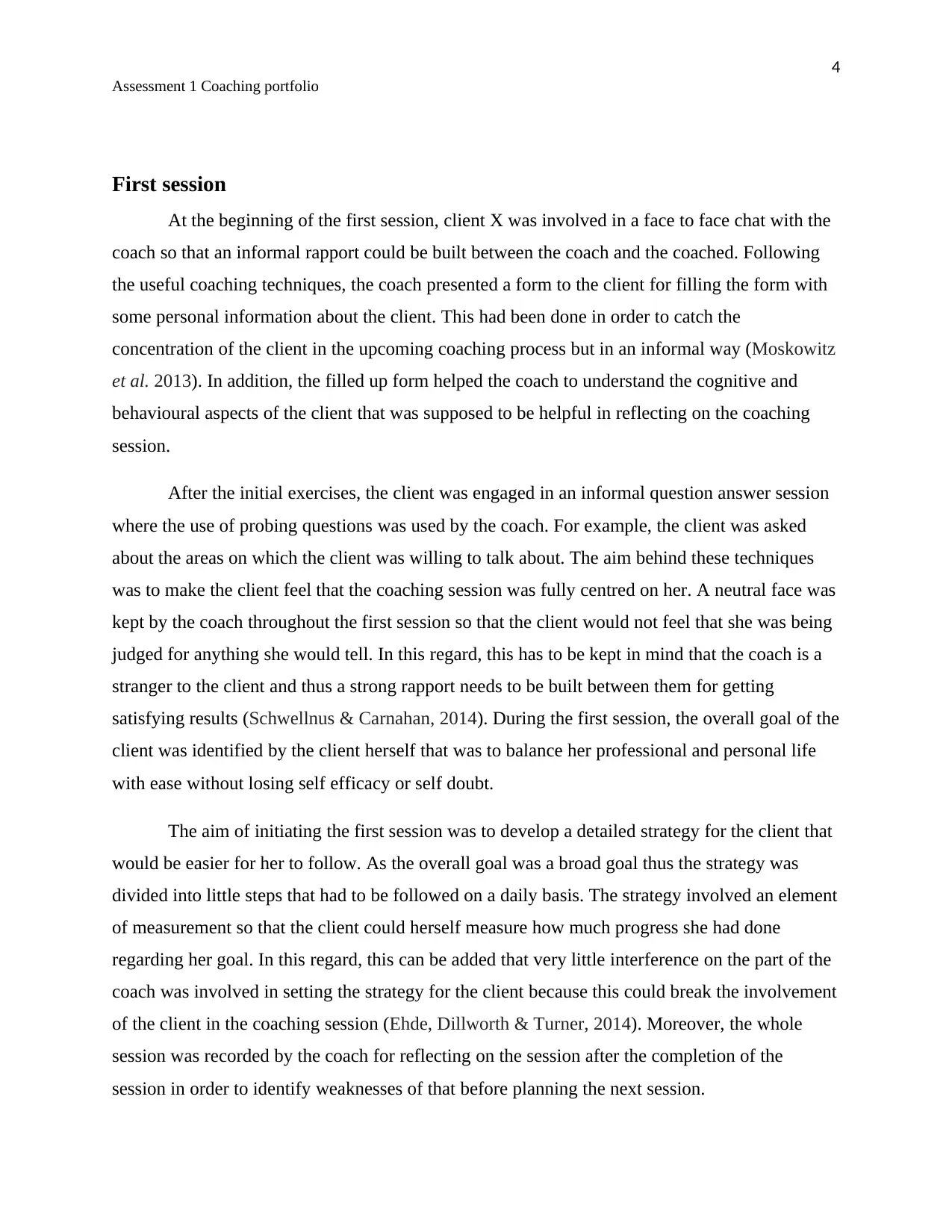
4
Assessment 1 Coaching portfolio
First session
At the beginning of the first session, client X was involved in a face to face chat with the
coach so that an informal rapport could be built between the coach and the coached. Following
the useful coaching techniques, the coach presented a form to the client for filling the form with
some personal information about the client. This had been done in order to catch the
concentration of the client in the upcoming coaching process but in an informal way (Moskowitz
et al. 2013). In addition, the filled up form helped the coach to understand the cognitive and
behavioural aspects of the client that was supposed to be helpful in reflecting on the coaching
session.
After the initial exercises, the client was engaged in an informal question answer session
where the use of probing questions was used by the coach. For example, the client was asked
about the areas on which the client was willing to talk about. The aim behind these techniques
was to make the client feel that the coaching session was fully centred on her. A neutral face was
kept by the coach throughout the first session so that the client would not feel that she was being
judged for anything she would tell. In this regard, this has to be kept in mind that the coach is a
stranger to the client and thus a strong rapport needs to be built between them for getting
satisfying results (Schwellnus & Carnahan, 2014). During the first session, the overall goal of the
client was identified by the client herself that was to balance her professional and personal life
with ease without losing self efficacy or self doubt.
The aim of initiating the first session was to develop a detailed strategy for the client that
would be easier for her to follow. As the overall goal was a broad goal thus the strategy was
divided into little steps that had to be followed on a daily basis. The strategy involved an element
of measurement so that the client could herself measure how much progress she had done
regarding her goal. In this regard, this can be added that very little interference on the part of the
coach was involved in setting the strategy for the client because this could break the involvement
of the client in the coaching session (Ehde, Dillworth & Turner, 2014). Moreover, the whole
session was recorded by the coach for reflecting on the session after the completion of the
session in order to identify weaknesses of that before planning the next session.
Assessment 1 Coaching portfolio
First session
At the beginning of the first session, client X was involved in a face to face chat with the
coach so that an informal rapport could be built between the coach and the coached. Following
the useful coaching techniques, the coach presented a form to the client for filling the form with
some personal information about the client. This had been done in order to catch the
concentration of the client in the upcoming coaching process but in an informal way (Moskowitz
et al. 2013). In addition, the filled up form helped the coach to understand the cognitive and
behavioural aspects of the client that was supposed to be helpful in reflecting on the coaching
session.
After the initial exercises, the client was engaged in an informal question answer session
where the use of probing questions was used by the coach. For example, the client was asked
about the areas on which the client was willing to talk about. The aim behind these techniques
was to make the client feel that the coaching session was fully centred on her. A neutral face was
kept by the coach throughout the first session so that the client would not feel that she was being
judged for anything she would tell. In this regard, this has to be kept in mind that the coach is a
stranger to the client and thus a strong rapport needs to be built between them for getting
satisfying results (Schwellnus & Carnahan, 2014). During the first session, the overall goal of the
client was identified by the client herself that was to balance her professional and personal life
with ease without losing self efficacy or self doubt.
The aim of initiating the first session was to develop a detailed strategy for the client that
would be easier for her to follow. As the overall goal was a broad goal thus the strategy was
divided into little steps that had to be followed on a daily basis. The strategy involved an element
of measurement so that the client could herself measure how much progress she had done
regarding her goal. In this regard, this can be added that very little interference on the part of the
coach was involved in setting the strategy for the client because this could break the involvement
of the client in the coaching session (Ehde, Dillworth & Turner, 2014). Moreover, the whole
session was recorded by the coach for reflecting on the session after the completion of the
session in order to identify weaknesses of that before planning the next session.

5
Assessment 1 Coaching portfolio
Last session
The last session was started with giving a feedback of the client on the previous session
and on how she improved herself by following the steps that was planned in the first session. In
this regard, this can mentioned that the client was first asked about the positive changes that she
felt after the last session and then was questioned about the problems that were left unsolved.
This has been done in order to build confidence in her and increase positivity in her perspectives
(Proyer, Gander, Wellenzohn & Ruch, 2014). On the other hand, this technique is important to
implement positive psychology in solving the problem faced by the client. In this final session,
the client and the coach reminded themselves about the goal that was identified in the first
session. Like other sessions, the coach used active listening skills to record every significant
change that the client informed the coach about.
The most important part of the final session was to take feedbacks from the client
regarding the whole coaching session. This implies that the client was asked questions about
whether she was benefitted from the coaching or not. The coachee responded that the coaching
sessions imposed a positive impact on her and her problems of anxiety and self doubt was
decreased over time. In addition, the client also informed that she followed the steps thoroughly
and as a result she is now a more confident person. One of the most significant elements of the
final session was to make the client realize her role in changing the way she thinks for solving
the problem she was facing (Bolier et al. 2013). Moreover, both the coach and the client agreed
on the deal that that the client will continue working on her personal development even after the
ending of the coaching session for achieving a sustainable improvement.
Own reflection
After the execution of all the five coaching sessions, I noticed that the overall coaching
process was successful as it helped the client to deal with herself efficacy issues. This evaluation
includes the feedback from the client who claimed that the coaching process was helpful for her
so much that she would like to involve in such type of interventions later in her life (Rogers,
2013). The whole coaching session revolved around achieving the goal set by the client at the
Assessment 1 Coaching portfolio
Last session
The last session was started with giving a feedback of the client on the previous session
and on how she improved herself by following the steps that was planned in the first session. In
this regard, this can mentioned that the client was first asked about the positive changes that she
felt after the last session and then was questioned about the problems that were left unsolved.
This has been done in order to build confidence in her and increase positivity in her perspectives
(Proyer, Gander, Wellenzohn & Ruch, 2014). On the other hand, this technique is important to
implement positive psychology in solving the problem faced by the client. In this final session,
the client and the coach reminded themselves about the goal that was identified in the first
session. Like other sessions, the coach used active listening skills to record every significant
change that the client informed the coach about.
The most important part of the final session was to take feedbacks from the client
regarding the whole coaching session. This implies that the client was asked questions about
whether she was benefitted from the coaching or not. The coachee responded that the coaching
sessions imposed a positive impact on her and her problems of anxiety and self doubt was
decreased over time. In addition, the client also informed that she followed the steps thoroughly
and as a result she is now a more confident person. One of the most significant elements of the
final session was to make the client realize her role in changing the way she thinks for solving
the problem she was facing (Bolier et al. 2013). Moreover, both the coach and the client agreed
on the deal that that the client will continue working on her personal development even after the
ending of the coaching session for achieving a sustainable improvement.
Own reflection
After the execution of all the five coaching sessions, I noticed that the overall coaching
process was successful as it helped the client to deal with herself efficacy issues. This evaluation
includes the feedback from the client who claimed that the coaching process was helpful for her
so much that she would like to involve in such type of interventions later in her life (Rogers,
2013). The whole coaching session revolved around achieving the goal set by the client at the
⊘ This is a preview!⊘
Do you want full access?
Subscribe today to unlock all pages.

Trusted by 1+ million students worldwide
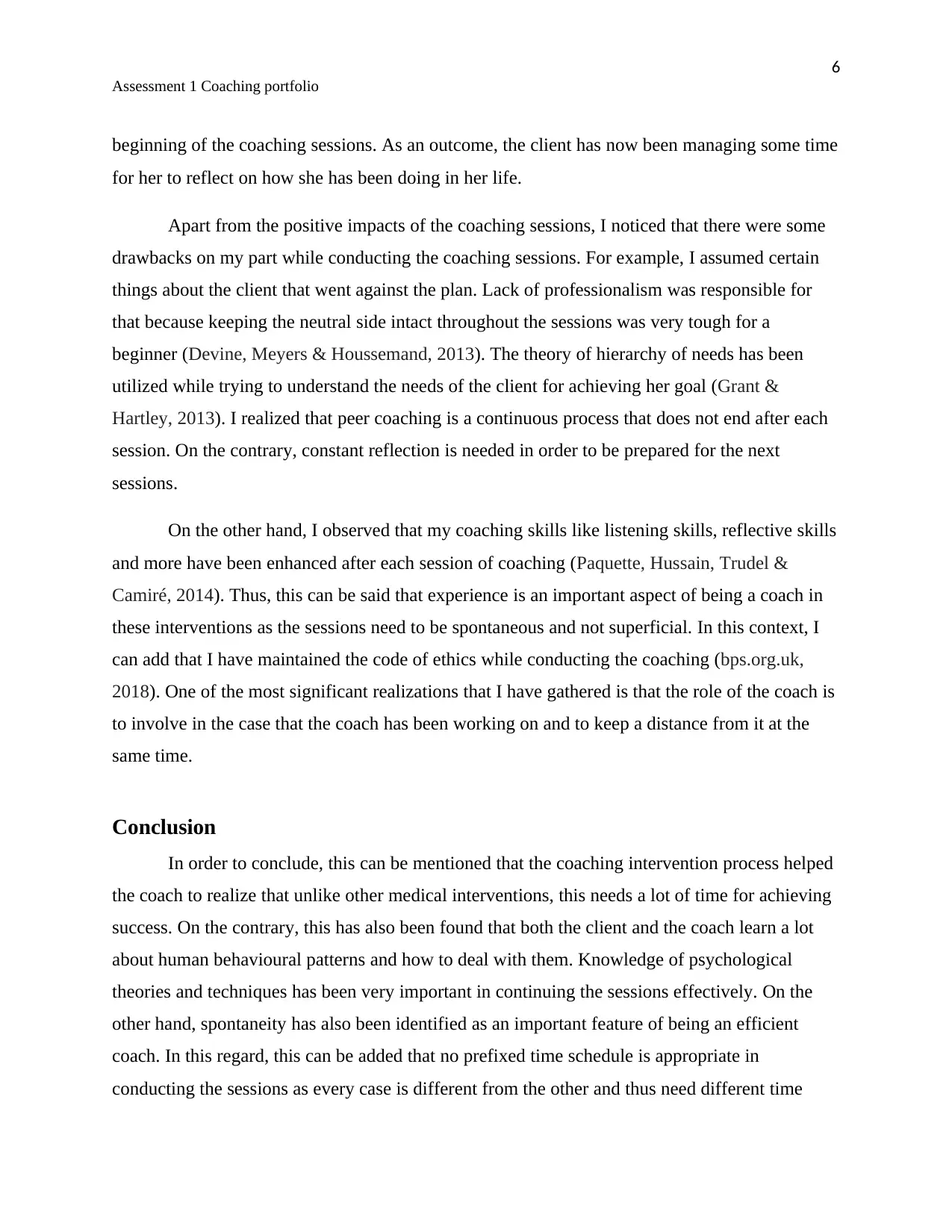
6
Assessment 1 Coaching portfolio
beginning of the coaching sessions. As an outcome, the client has now been managing some time
for her to reflect on how she has been doing in her life.
Apart from the positive impacts of the coaching sessions, I noticed that there were some
drawbacks on my part while conducting the coaching sessions. For example, I assumed certain
things about the client that went against the plan. Lack of professionalism was responsible for
that because keeping the neutral side intact throughout the sessions was very tough for a
beginner (Devine, Meyers & Houssemand, 2013). The theory of hierarchy of needs has been
utilized while trying to understand the needs of the client for achieving her goal (Grant &
Hartley, 2013). I realized that peer coaching is a continuous process that does not end after each
session. On the contrary, constant reflection is needed in order to be prepared for the next
sessions.
On the other hand, I observed that my coaching skills like listening skills, reflective skills
and more have been enhanced after each session of coaching (Paquette, Hussain, Trudel &
Camiré, 2014). Thus, this can be said that experience is an important aspect of being a coach in
these interventions as the sessions need to be spontaneous and not superficial. In this context, I
can add that I have maintained the code of ethics while conducting the coaching (bps.org.uk,
2018). One of the most significant realizations that I have gathered is that the role of the coach is
to involve in the case that the coach has been working on and to keep a distance from it at the
same time.
Conclusion
In order to conclude, this can be mentioned that the coaching intervention process helped
the coach to realize that unlike other medical interventions, this needs a lot of time for achieving
success. On the contrary, this has also been found that both the client and the coach learn a lot
about human behavioural patterns and how to deal with them. Knowledge of psychological
theories and techniques has been very important in continuing the sessions effectively. On the
other hand, spontaneity has also been identified as an important feature of being an efficient
coach. In this regard, this can be added that no prefixed time schedule is appropriate in
conducting the sessions as every case is different from the other and thus need different time
Assessment 1 Coaching portfolio
beginning of the coaching sessions. As an outcome, the client has now been managing some time
for her to reflect on how she has been doing in her life.
Apart from the positive impacts of the coaching sessions, I noticed that there were some
drawbacks on my part while conducting the coaching sessions. For example, I assumed certain
things about the client that went against the plan. Lack of professionalism was responsible for
that because keeping the neutral side intact throughout the sessions was very tough for a
beginner (Devine, Meyers & Houssemand, 2013). The theory of hierarchy of needs has been
utilized while trying to understand the needs of the client for achieving her goal (Grant &
Hartley, 2013). I realized that peer coaching is a continuous process that does not end after each
session. On the contrary, constant reflection is needed in order to be prepared for the next
sessions.
On the other hand, I observed that my coaching skills like listening skills, reflective skills
and more have been enhanced after each session of coaching (Paquette, Hussain, Trudel &
Camiré, 2014). Thus, this can be said that experience is an important aspect of being a coach in
these interventions as the sessions need to be spontaneous and not superficial. In this context, I
can add that I have maintained the code of ethics while conducting the coaching (bps.org.uk,
2018). One of the most significant realizations that I have gathered is that the role of the coach is
to involve in the case that the coach has been working on and to keep a distance from it at the
same time.
Conclusion
In order to conclude, this can be mentioned that the coaching intervention process helped
the coach to realize that unlike other medical interventions, this needs a lot of time for achieving
success. On the contrary, this has also been found that both the client and the coach learn a lot
about human behavioural patterns and how to deal with them. Knowledge of psychological
theories and techniques has been very important in continuing the sessions effectively. On the
other hand, spontaneity has also been identified as an important feature of being an efficient
coach. In this regard, this can be added that no prefixed time schedule is appropriate in
conducting the sessions as every case is different from the other and thus need different time
Paraphrase This Document
Need a fresh take? Get an instant paraphrase of this document with our AI Paraphraser
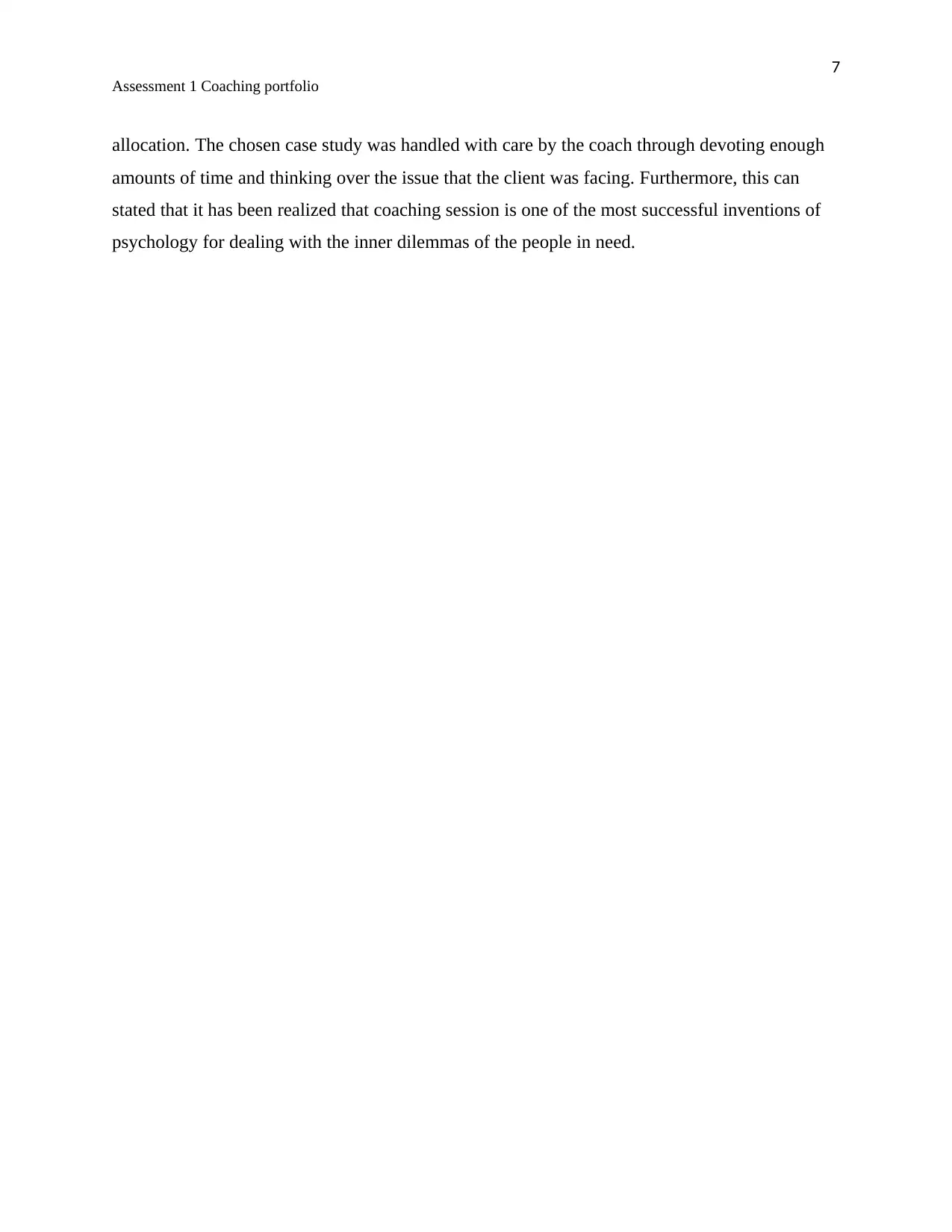
7
Assessment 1 Coaching portfolio
allocation. The chosen case study was handled with care by the coach through devoting enough
amounts of time and thinking over the issue that the client was facing. Furthermore, this can
stated that it has been realized that coaching session is one of the most successful inventions of
psychology for dealing with the inner dilemmas of the people in need.
Assessment 1 Coaching portfolio
allocation. The chosen case study was handled with care by the coach through devoting enough
amounts of time and thinking over the issue that the client was facing. Furthermore, this can
stated that it has been realized that coaching session is one of the most successful inventions of
psychology for dealing with the inner dilemmas of the people in need.

8
Assessment 1 Coaching portfolio
Reference list
Bolier, L., Haverman, M., Westerhof, G. J., Riper, H., Smit, F., & Bohlmeijer, E. (2013).
Positive psychology interventions: a meta-analysis of randomized controlled
studies. BMC public health, 13(1), 119. Retrieved on: 3rd Jan, From:
https://bmcpublichealth.biomedcentral.com/articles/10.1186/1471-2458-13-119
bps.org.uk, (2018), Standards and Guidelines, Retrieved on: 3rd Jan, From:
https://www.bps.org.uk/psychologists/standards-and-guidelines
de Haan, E., Duckworth, A., Birch, D., & Jones, C. (2013). Executive coaching outcome
research: The contribution of common factors such as relationship, personality match,
and self-efficacy. Consulting Psychology Journal: Practice and Research, 65(1), 40.
Retrieved on: 3rd Jan, From:
http://www.erikdehaan.com/wp-content/uploads/2013/08/2013_Executive-coaching-
outcome-research-the-predictive-value-of-common%C2%A0factors-such-as-relationship-
personality-match-and-self-efficacy.pdf
Devine, M., Meyers, R., & Houssemand, C. (2013). How can coaching make a positive impact
within educational settings?. Procedia Social and Behavioral Sciences, 93(1), 1382-1389.
Retrieved on: 3rd Jan, From: http://publications.uni.lu/bitstream/10993/12001/1/Devine-
Meyers-Procedia-2013.pdf
Ehde, D. M., Dillworth, T. M., & Turner, J. A. (2014). Cognitive-behavioral therapy for
individuals with chronic pain: efficacy, innovations, and directions for
research. American Psychologist, 69(2), 153. Retrieved on: 3rd Jan, From:
https://books.apa.org/pubs/journals/releases/amp-a0035747.pdf
Grant, A. M., & Hartley, M. (2013). Developing the leader as coach: insights, strategies and tips
for embedding coaching skills in the workplace. Coaching: An International Journal of
Theory, Research and Practice, 6(2), 102-115. Retrieved on: 3rd Jan, From:
https://www.tandfonline.com/doi/full/10.1080/17521882.2013.824015
Assessment 1 Coaching portfolio
Reference list
Bolier, L., Haverman, M., Westerhof, G. J., Riper, H., Smit, F., & Bohlmeijer, E. (2013).
Positive psychology interventions: a meta-analysis of randomized controlled
studies. BMC public health, 13(1), 119. Retrieved on: 3rd Jan, From:
https://bmcpublichealth.biomedcentral.com/articles/10.1186/1471-2458-13-119
bps.org.uk, (2018), Standards and Guidelines, Retrieved on: 3rd Jan, From:
https://www.bps.org.uk/psychologists/standards-and-guidelines
de Haan, E., Duckworth, A., Birch, D., & Jones, C. (2013). Executive coaching outcome
research: The contribution of common factors such as relationship, personality match,
and self-efficacy. Consulting Psychology Journal: Practice and Research, 65(1), 40.
Retrieved on: 3rd Jan, From:
http://www.erikdehaan.com/wp-content/uploads/2013/08/2013_Executive-coaching-
outcome-research-the-predictive-value-of-common%C2%A0factors-such-as-relationship-
personality-match-and-self-efficacy.pdf
Devine, M., Meyers, R., & Houssemand, C. (2013). How can coaching make a positive impact
within educational settings?. Procedia Social and Behavioral Sciences, 93(1), 1382-1389.
Retrieved on: 3rd Jan, From: http://publications.uni.lu/bitstream/10993/12001/1/Devine-
Meyers-Procedia-2013.pdf
Ehde, D. M., Dillworth, T. M., & Turner, J. A. (2014). Cognitive-behavioral therapy for
individuals with chronic pain: efficacy, innovations, and directions for
research. American Psychologist, 69(2), 153. Retrieved on: 3rd Jan, From:
https://books.apa.org/pubs/journals/releases/amp-a0035747.pdf
Grant, A. M., & Hartley, M. (2013). Developing the leader as coach: insights, strategies and tips
for embedding coaching skills in the workplace. Coaching: An International Journal of
Theory, Research and Practice, 6(2), 102-115. Retrieved on: 3rd Jan, From:
https://www.tandfonline.com/doi/full/10.1080/17521882.2013.824015
⊘ This is a preview!⊘
Do you want full access?
Subscribe today to unlock all pages.

Trusted by 1+ million students worldwide
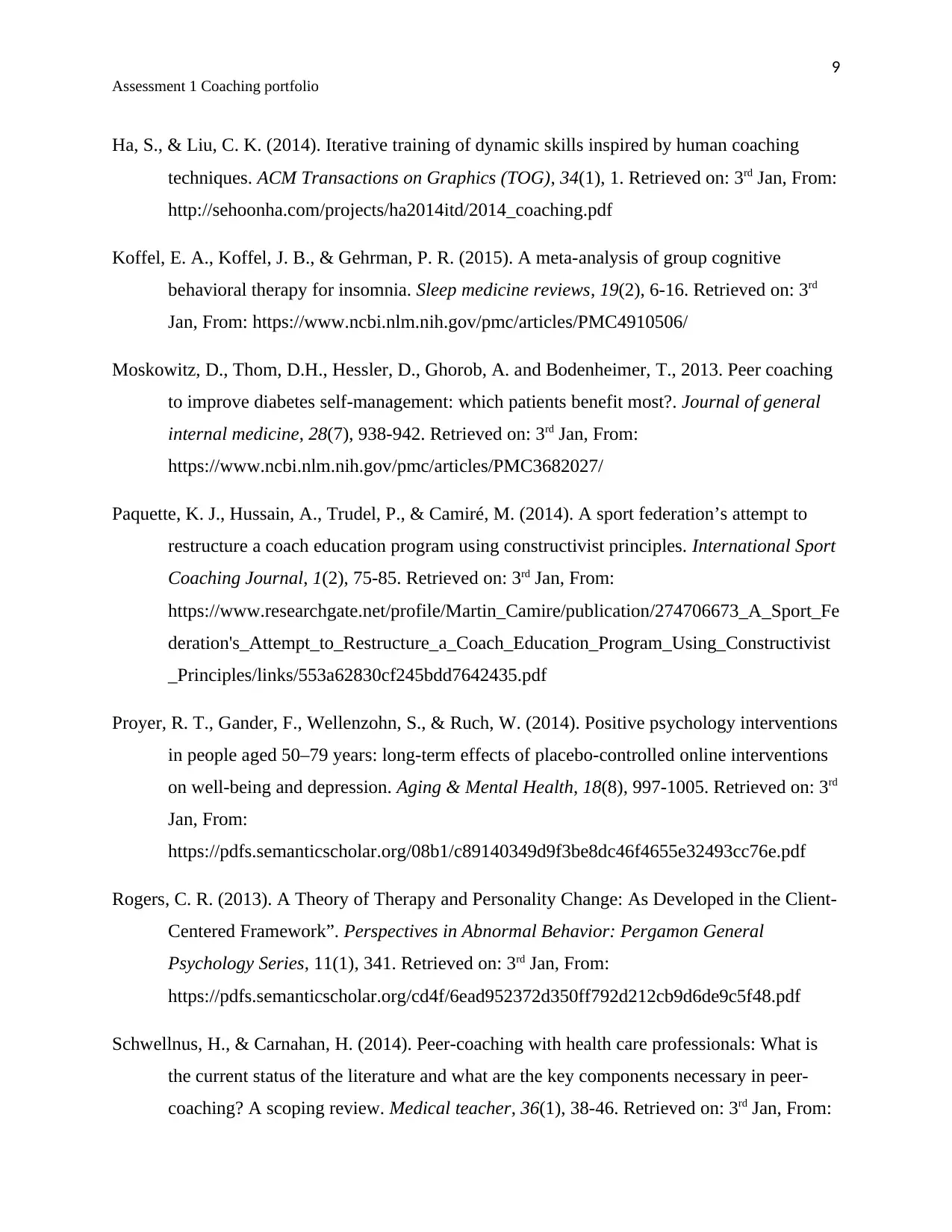
9
Assessment 1 Coaching portfolio
Ha, S., & Liu, C. K. (2014). Iterative training of dynamic skills inspired by human coaching
techniques. ACM Transactions on Graphics (TOG), 34(1), 1. Retrieved on: 3rd Jan, From:
http://sehoonha.com/projects/ha2014itd/2014_coaching.pdf
Koffel, E. A., Koffel, J. B., & Gehrman, P. R. (2015). A meta-analysis of group cognitive
behavioral therapy for insomnia. Sleep medicine reviews, 19(2), 6-16. Retrieved on: 3rd
Jan, From: https://www.ncbi.nlm.nih.gov/pmc/articles/PMC4910506/
Moskowitz, D., Thom, D.H., Hessler, D., Ghorob, A. and Bodenheimer, T., 2013. Peer coaching
to improve diabetes self-management: which patients benefit most?. Journal of general
internal medicine, 28(7), 938-942. Retrieved on: 3rd Jan, From:
https://www.ncbi.nlm.nih.gov/pmc/articles/PMC3682027/
Paquette, K. J., Hussain, A., Trudel, P., & Camiré, M. (2014). A sport federation’s attempt to
restructure a coach education program using constructivist principles. International Sport
Coaching Journal, 1(2), 75-85. Retrieved on: 3rd Jan, From:
https://www.researchgate.net/profile/Martin_Camire/publication/274706673_A_Sport_Fe
deration's_Attempt_to_Restructure_a_Coach_Education_Program_Using_Constructivist
_Principles/links/553a62830cf245bdd7642435.pdf
Proyer, R. T., Gander, F., Wellenzohn, S., & Ruch, W. (2014). Positive psychology interventions
in people aged 50–79 years: long-term effects of placebo-controlled online interventions
on well-being and depression. Aging & Mental Health, 18(8), 997-1005. Retrieved on: 3rd
Jan, From:
https://pdfs.semanticscholar.org/08b1/c89140349d9f3be8dc46f4655e32493cc76e.pdf
Rogers, C. R. (2013). A Theory of Therapy and Personality Change: As Developed in the Client-
Centered Framework”. Perspectives in Abnormal Behavior: Pergamon General
Psychology Series, 11(1), 341. Retrieved on: 3rd Jan, From:
https://pdfs.semanticscholar.org/cd4f/6ead952372d350ff792d212cb9d6de9c5f48.pdf
Schwellnus, H., & Carnahan, H. (2014). Peer-coaching with health care professionals: What is
the current status of the literature and what are the key components necessary in peer-
coaching? A scoping review. Medical teacher, 36(1), 38-46. Retrieved on: 3rd Jan, From:
Assessment 1 Coaching portfolio
Ha, S., & Liu, C. K. (2014). Iterative training of dynamic skills inspired by human coaching
techniques. ACM Transactions on Graphics (TOG), 34(1), 1. Retrieved on: 3rd Jan, From:
http://sehoonha.com/projects/ha2014itd/2014_coaching.pdf
Koffel, E. A., Koffel, J. B., & Gehrman, P. R. (2015). A meta-analysis of group cognitive
behavioral therapy for insomnia. Sleep medicine reviews, 19(2), 6-16. Retrieved on: 3rd
Jan, From: https://www.ncbi.nlm.nih.gov/pmc/articles/PMC4910506/
Moskowitz, D., Thom, D.H., Hessler, D., Ghorob, A. and Bodenheimer, T., 2013. Peer coaching
to improve diabetes self-management: which patients benefit most?. Journal of general
internal medicine, 28(7), 938-942. Retrieved on: 3rd Jan, From:
https://www.ncbi.nlm.nih.gov/pmc/articles/PMC3682027/
Paquette, K. J., Hussain, A., Trudel, P., & Camiré, M. (2014). A sport federation’s attempt to
restructure a coach education program using constructivist principles. International Sport
Coaching Journal, 1(2), 75-85. Retrieved on: 3rd Jan, From:
https://www.researchgate.net/profile/Martin_Camire/publication/274706673_A_Sport_Fe
deration's_Attempt_to_Restructure_a_Coach_Education_Program_Using_Constructivist
_Principles/links/553a62830cf245bdd7642435.pdf
Proyer, R. T., Gander, F., Wellenzohn, S., & Ruch, W. (2014). Positive psychology interventions
in people aged 50–79 years: long-term effects of placebo-controlled online interventions
on well-being and depression. Aging & Mental Health, 18(8), 997-1005. Retrieved on: 3rd
Jan, From:
https://pdfs.semanticscholar.org/08b1/c89140349d9f3be8dc46f4655e32493cc76e.pdf
Rogers, C. R. (2013). A Theory of Therapy and Personality Change: As Developed in the Client-
Centered Framework”. Perspectives in Abnormal Behavior: Pergamon General
Psychology Series, 11(1), 341. Retrieved on: 3rd Jan, From:
https://pdfs.semanticscholar.org/cd4f/6ead952372d350ff792d212cb9d6de9c5f48.pdf
Schwellnus, H., & Carnahan, H. (2014). Peer-coaching with health care professionals: What is
the current status of the literature and what are the key components necessary in peer-
coaching? A scoping review. Medical teacher, 36(1), 38-46. Retrieved on: 3rd Jan, From:
Paraphrase This Document
Need a fresh take? Get an instant paraphrase of this document with our AI Paraphraser

10
Assessment 1 Coaching portfolio
https://www.researchgate.net/profile/Heather_Carnahan/publication/257460745_Peer-
coaching_with_health_care_professionals_What_is_the_current_status_of_the_literature
_and_what_are_the_key_components_necessary_in_peer-coaching_A_scoping_review/
links/5550ba0a08ae739bdb91fa01.pdf
scrumalliance.org, (2018), Coaching Models: FUEL and GROW, Retrieved on: 3rd Jan, From:
https://www.scrumalliance.org/community/articles/2013/october/coaching-models-fuel-
and-grow
Thom, D. H., Ghorob, A., Hessler, D., De Vore, D., Chen, E., & Bodenheimer, T. A. (2013).
Impact of peer health coaching on glycemic control in low-income patients with diabetes:
a randomized controlled trial. The Annals of Family Medicine, 11(2), 137-144. Retrieved
on: 3rd Jan, From: http://www.annfammed.org/content/11/2/137.full.pdf
Vella, S. A., Oades, L. G., & Crowe, T. P. (2013). The relationship between coach leadership,
the coach–athlete relationship, team success, and the positive developmental experiences
of adolescent soccer players. Physical education and sport pedagogy, 18(5), 549-561.
Retrieved on: 3rd Jan, From: http://ro.uow.edu.au/cgi/viewcontent.cgi?
article=1460&context=sspapers\
Assessment 1 Coaching portfolio
https://www.researchgate.net/profile/Heather_Carnahan/publication/257460745_Peer-
coaching_with_health_care_professionals_What_is_the_current_status_of_the_literature
_and_what_are_the_key_components_necessary_in_peer-coaching_A_scoping_review/
links/5550ba0a08ae739bdb91fa01.pdf
scrumalliance.org, (2018), Coaching Models: FUEL and GROW, Retrieved on: 3rd Jan, From:
https://www.scrumalliance.org/community/articles/2013/october/coaching-models-fuel-
and-grow
Thom, D. H., Ghorob, A., Hessler, D., De Vore, D., Chen, E., & Bodenheimer, T. A. (2013).
Impact of peer health coaching on glycemic control in low-income patients with diabetes:
a randomized controlled trial. The Annals of Family Medicine, 11(2), 137-144. Retrieved
on: 3rd Jan, From: http://www.annfammed.org/content/11/2/137.full.pdf
Vella, S. A., Oades, L. G., & Crowe, T. P. (2013). The relationship between coach leadership,
the coach–athlete relationship, team success, and the positive developmental experiences
of adolescent soccer players. Physical education and sport pedagogy, 18(5), 549-561.
Retrieved on: 3rd Jan, From: http://ro.uow.edu.au/cgi/viewcontent.cgi?
article=1460&context=sspapers\
1 out of 11
Related Documents
Your All-in-One AI-Powered Toolkit for Academic Success.
+13062052269
info@desklib.com
Available 24*7 on WhatsApp / Email
![[object Object]](/_next/static/media/star-bottom.7253800d.svg)
Unlock your academic potential
Copyright © 2020–2025 A2Z Services. All Rights Reserved. Developed and managed by ZUCOL.





